Abstract
We have transferred the human gene for hypoxanthine-guanine phosphoribosyltransferase (HPRT, EC 2.4.2.8; IMP:pyrophosphate phosphoribosyltransferease) via isolated metaphase chromosomes from human HeLa S3 cells into murine A9 cells which lack functional murine HPRT activity, using the technique of McBride and Ozer (Proc, Nat. Acad. Sci. USA 70, 1258-1262, 1973). Three transformed clones were isolated which contained human HPRT activity as determined by electrophoretic and immunochemical assays. Twenty human isozymes other than HPRT whose genes have been assigned to 14 human chromosomes were found to be absent in our transformed clones. Moreover, the human isozymes of hlucose-6-phosphate dehydrogenase (EC 1.1.1.49; D-glucose 6-phosphate:NADP 1-oxidoreductase) and phosphoglycerate kinase (EC 2.7.2.3;ATP:3-phospho-D-glycerate 1-phosphotransferase), whose genes have been linked with the HPRT gene to the long are of the human X chromosome, were also absent. On the basis of the known linkage relationships of the three markers, we thereby suggest that the transferred piece of human genetic material is smaller than 20% of the human X chromosome or less than 1% of the human genome. This estimate assumes a normal syntenic relationship for the long arm of the X chromosome in HeLa S3 cells. In agreement with this conclusion, no human chromosomes could be detected in our transformed clones. When grown under nonselective conditions about 3% of the gene transfer cells lost the human HPRT marker per cell generation. Transformants that had lost human HPRT activity were subjected to hypoxanthine-aminopterin-thymidine selection. The frequency of revertants to the HPRT(+) phenotype was less than 1 x 10(-6), and two revertants that were obtained possessed the mouse electrophoretic phenotype. These results argue against a stable integration of the human donor genetic material into the mouse recipient genome.
Full text
PDF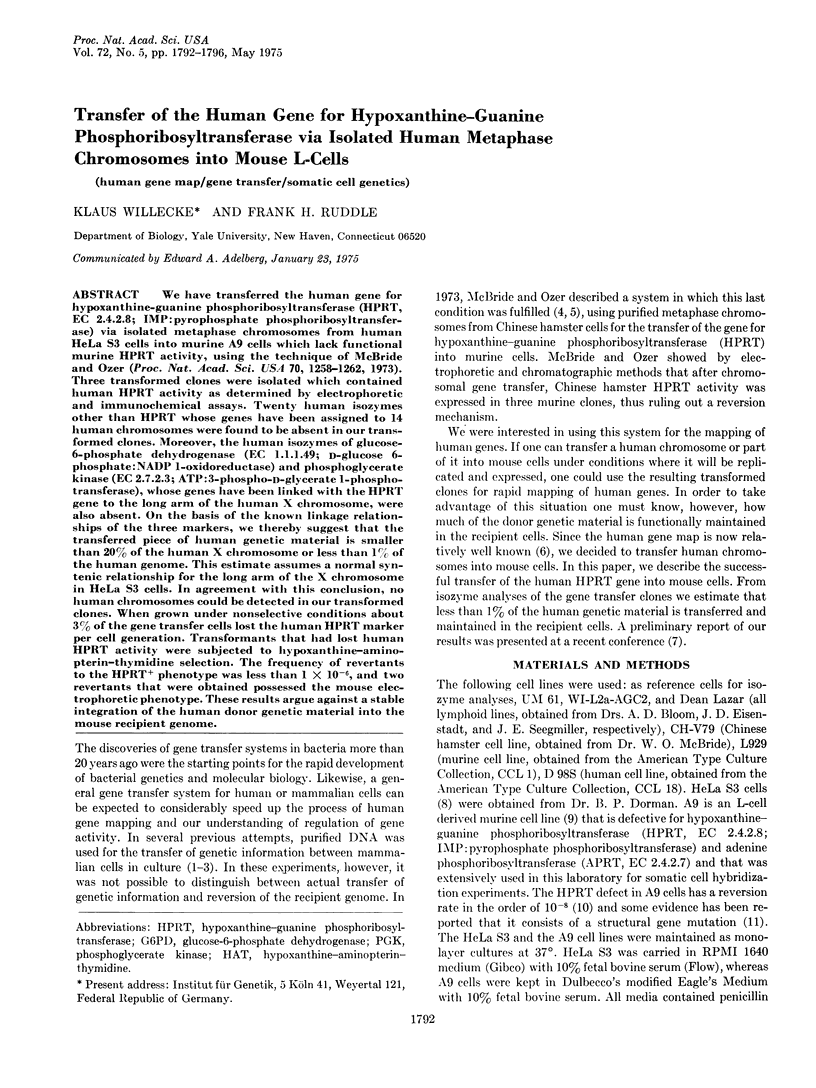
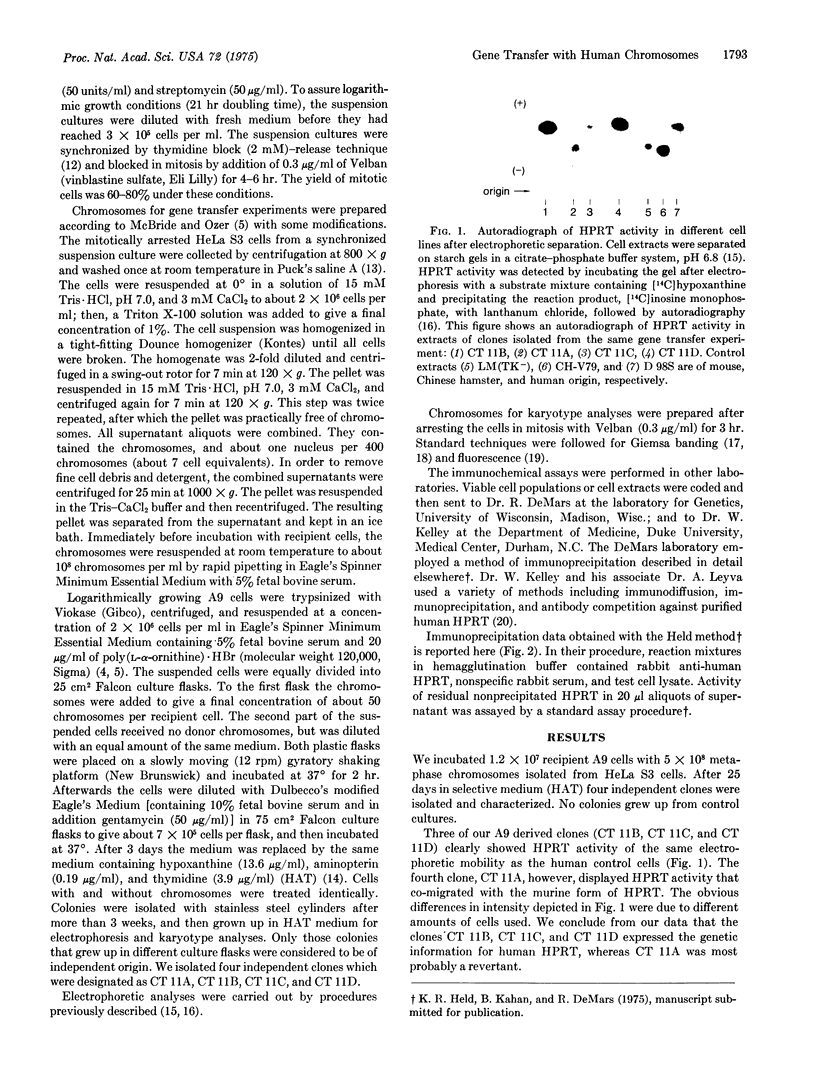
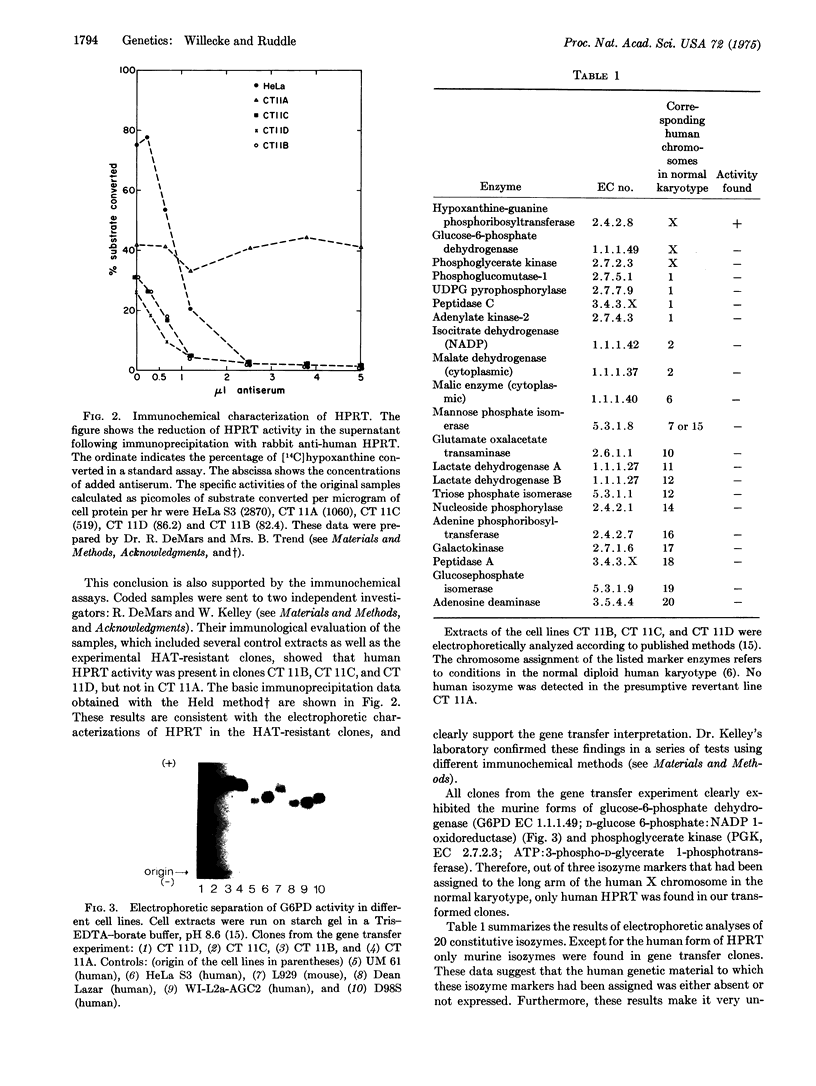
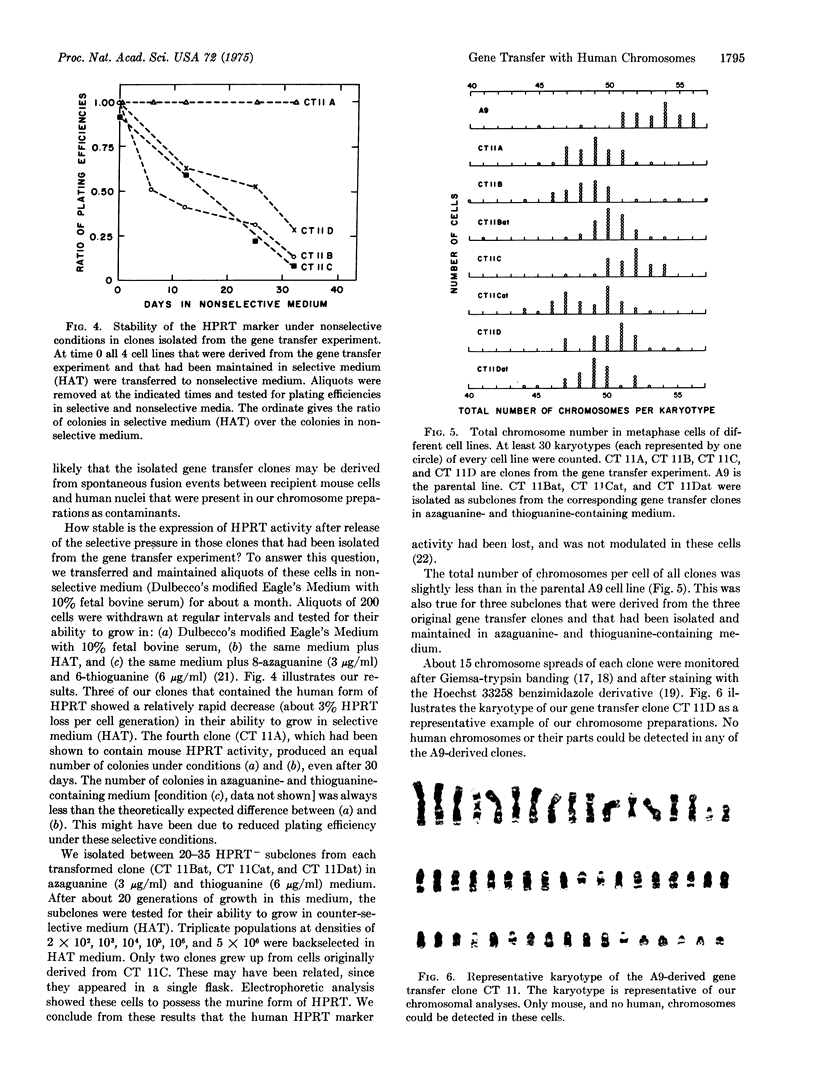
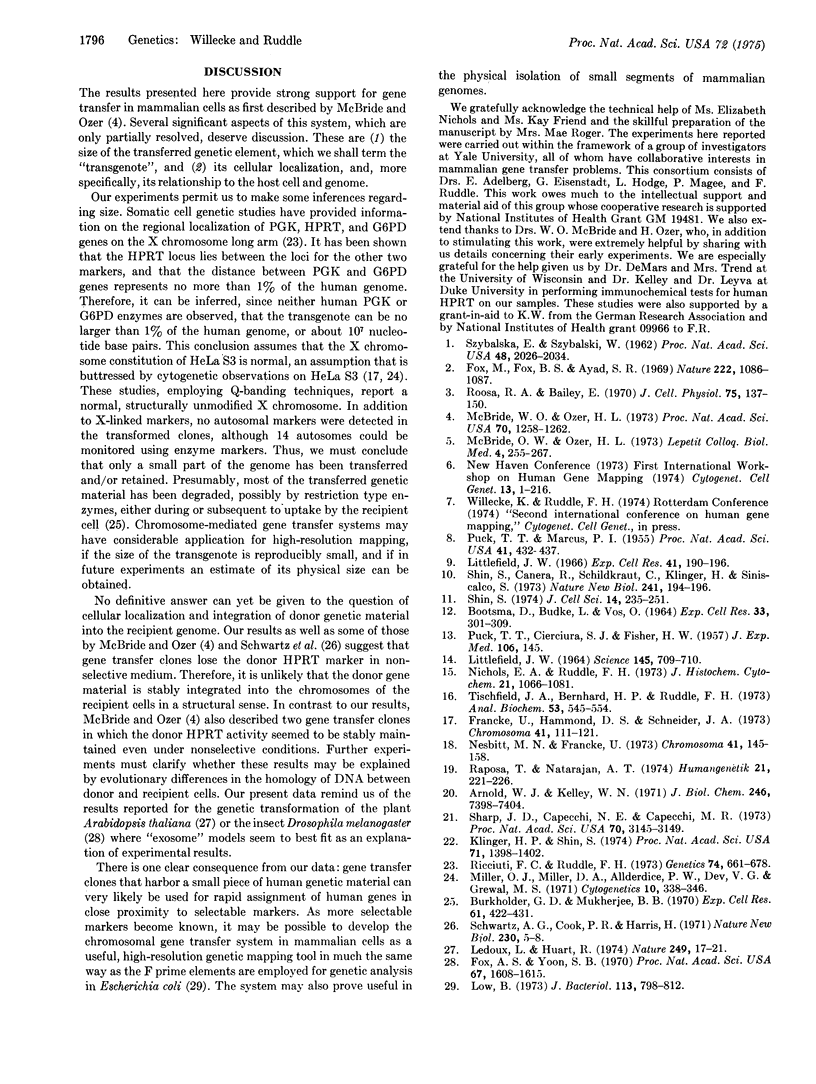
Images in this article
Selected References
These references are in PubMed. This may not be the complete list of references from this article.
- Arnold W. J., Kelley W. N. Human hypoxanthine-guanine phosphoribosyltransferase. Purification and subunit structure. J Biol Chem. 1971 Dec 10;246(23):7398–7404. [PubMed] [Google Scholar]
- BOOTSMA D., BUDKE L., VOS O. STUDIES ON SYNCHRONOUS DIVISION OF TISSUE CULTURE CELLS INITIATED BY EXCESS THYMIDINE. Exp Cell Res. 1964 Jan;33:301–309. doi: 10.1016/s0014-4827(64)81035-1. [DOI] [PubMed] [Google Scholar]
- Burkholder G. D., Mukherjee B. B. Uptake of isolated metaphase chromosomes by mammalian cells in vitro. Exp Cell Res. 1970 Aug;61(2):413–422. doi: 10.1016/0014-4827(70)90466-0. [DOI] [PubMed] [Google Scholar]
- Fox A. S., Yoon S. B. DNA-induced transformation in Drosophila: locus-specificity and the establishment of transformed stocks. Proc Natl Acad Sci U S A. 1970 Nov;67(3):1608–1615. doi: 10.1073/pnas.67.3.1608. [DOI] [PMC free article] [PubMed] [Google Scholar]
- Fox M., Fox B. W., Ayad S. R. Evidence for genetic expression of integrated DNA in lymphoma cells. Nature. 1969 Jun 14;222(5198):1086–1087. doi: 10.1038/2221086a0. [DOI] [PubMed] [Google Scholar]
- Francke U., Hammond D. S., Schneider J. A. The band patterns of twelve D 98-AH-2 marker chromosomes and their use for identification of intraspecific cell hybrids. Chromosoma. 1973;41(1):111–121. doi: 10.1007/BF00284079. [DOI] [PubMed] [Google Scholar]
- Klinger H. P., Shin S. I. Modulation of the activity of an avian gene transferred into a mammalian cell by cell fusion. Proc Natl Acad Sci U S A. 1974 Apr;71(4):1398–1402. doi: 10.1073/pnas.71.4.1398. [DOI] [PMC free article] [PubMed] [Google Scholar]
- LITTLEFIELD J. W. SELECTION OF HYBRIDS FROM MATINGS OF FIBROBLASTS IN VITRO AND THEIR PRESUMED RECOMBINANTS. Science. 1964 Aug 14;145(3633):709–710. doi: 10.1126/science.145.3633.709. [DOI] [PubMed] [Google Scholar]
- Ledoux L., Huart R., Jacobs M. DNA-mediated genetic correction of thiamineless Arabidopsis thaliana. Nature. 1974 May 3;249(452):17–21. doi: 10.1038/249017a0. [DOI] [PubMed] [Google Scholar]
- Littlefield J. W. The use of drug-resistant markers to study the hybridization of mouse fibroblasts. Exp Cell Res. 1966 Jan;41(1):190–196. doi: 10.1016/0014-4827(66)90558-1. [DOI] [PubMed] [Google Scholar]
- Low B. Rapid mapping of conditional and auxotrophic mutations in Escherichia coli K-12. J Bacteriol. 1973 Feb;113(2):798–812. doi: 10.1128/jb.113.2.798-812.1973. [DOI] [PMC free article] [PubMed] [Google Scholar]
- McBride O. W., Ozer H. L. Transfer of genetic information by purified metaphase chromosomes. Proc Natl Acad Sci U S A. 1973 Apr;70(4):1258–1262. doi: 10.1073/pnas.70.4.1258. [DOI] [PMC free article] [PubMed] [Google Scholar]
- Miller O. J., Miller D. A., Allderdice P. W., Dev V. G., Grewal M. S. Quinacrine fluorescent karyotypes of human diploid and heteroploid cell lines. Cytogenetics. 1971;10(5):338–346. doi: 10.1159/000130152. [DOI] [PubMed] [Google Scholar]
- Nesbitt M. N., Francke U. A system of nomenclature for band patterns of mouse chromosomes. Chromosoma. 1973;41(2):145–158. doi: 10.1007/BF00319691. [DOI] [PubMed] [Google Scholar]
- Nichols E. A., Ruddle F. H. A review of enzyme polymorphism, linkage and electrophoretic conditions for mouse and somatic cell hybrids in starch gels. J Histochem Cytochem. 1973 Dec;21(12):1066–1081. doi: 10.1177/21.12.1066. [DOI] [PubMed] [Google Scholar]
- PUCK T. T., CIECIURA S. J., FISHER H. W. Clonal growth in vitro of human cells with fibroblastic morphology; comparison of growth and genetic characteristics of single epithelioid and fibroblast-like cells from a variety of human organs. J Exp Med. 1957 Jul 1;106(1):145–158. doi: 10.1084/jem.106.1.145. [DOI] [PMC free article] [PubMed] [Google Scholar]
- Puck T. T., Marcus P. I. A RAPID METHOD FOR VIABLE CELL TITRATION AND CLONE PRODUCTION WITH HELA CELLS IN TISSUE CULTURE: THE USE OF X-IRRADIATED CELLS TO SUPPLY CONDITIONING FACTORS. Proc Natl Acad Sci U S A. 1955 Jul 15;41(7):432–437. doi: 10.1073/pnas.41.7.432. [DOI] [PMC free article] [PubMed] [Google Scholar]
- Raposa T., Natarajan A. T. Fluorescence banding pattern of human and mouse chromosomes with a benzimidazol derivative (Hoechst 33258). Humangenetik. 1974;21(3):221–226. doi: 10.1007/BF00279016. [DOI] [PubMed] [Google Scholar]
- Ricciuti F. C., Ruddle F. H. Assignment of three gene loci (PGK, HGPRT, G6PD) to the long arm of the human X chromosome by somatic cell genetics. Genetics. 1973 Aug;74(4):661–678. doi: 10.1093/genetics/74.4.661. [DOI] [PMC free article] [PubMed] [Google Scholar]
- Roosa R. A., Bailey E. DNA-mediated transformation of mammalian cells in culture. Increased transforming efficiency following sonication. J Cell Physiol. 1970 Apr;75(2):137–150. doi: 10.1002/jcp.1040750202. [DOI] [PubMed] [Google Scholar]
- SZYBALSKA E. H., SZYBALSKI W. Genetics of human cess line. IV. DNA-mediated heritable transformation of a biochemical trait. Proc Natl Acad Sci U S A. 1962 Dec 15;48:2026–2034. doi: 10.1073/pnas.48.12.2026. [DOI] [PMC free article] [PubMed] [Google Scholar]
- Schwartz A. G., Cook P. R., Harris H. Correction of a genetic defect in a mammalian cell. Nat New Biol. 1971 Mar 3;230(1):5–8. doi: 10.1038/newbio230005a0. [DOI] [PubMed] [Google Scholar]
- Sharp J. D., Capecchi N. E., Capecchi M. R. Altered enzymes in drug-resistant variants of mammalian tissue culture cells. Proc Natl Acad Sci U S A. 1973 Nov;70(11):3145–3149. doi: 10.1073/pnas.70.11.3145. [DOI] [PMC free article] [PubMed] [Google Scholar]
- Shin S. I. Nature of mutations conferring resistance to 8-azaguanine in mouse cell lines. J Cell Sci. 1974 Mar;14(2):235–251. doi: 10.1242/jcs.14.2.235. [DOI] [PubMed] [Google Scholar]
- Shin S., Caneva R., Schildkraut C. L., Klinger H. P., Siniscalco M. Cells with phosphoribosyl transferase activity recovered from mouse cells resistant to 8-azaguanine. Nat New Biol. 1973 Feb 14;241(111):194–196. doi: 10.1038/newbio241194a0. [DOI] [PubMed] [Google Scholar]
- Tischfield J. A., Bernhard H. P., Ruddle F. H. A new electrophoretic-autoradiographic method for the visual detection of phosphotransferases. Anal Biochem. 1973 Jun;53(2):545–554. doi: 10.1016/0003-2697(73)90105-x. [DOI] [PubMed] [Google Scholar]





